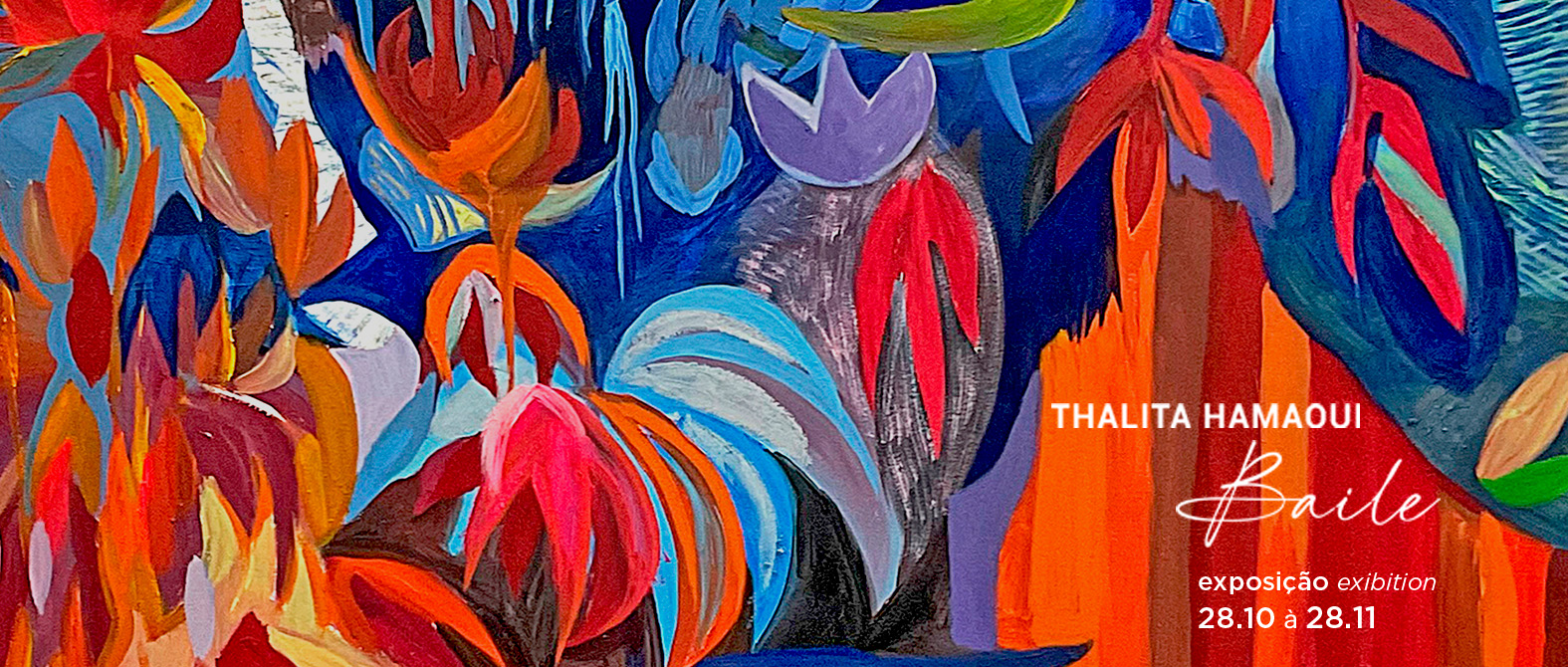Thalita Hamaoui – Baile
Victor Gorgulho
Tudo na natureza dança. Apesar de constantemente mimetizar um aspecto estático, como se repousasse em completa placidez e silêncio, todo ecossistema natural está a vibrar, incessantemente, em uma fascinante e infinda miríade de processos internos e externos invisíveis ao olho humano. É esta espécie de fenômeno exuberante e efêmero performado pela natureza aquilo que parece residir no núcleo de cada uma das pinturas de Thalita Hamaoui.A Alban tem o prazer de anunciar a primeira exposição individual da artista paulista em sua galeria, ocupando o espaço expositivo com cerca de quinze obras inéditas realizadas nos últimos dois anos. Hamaoui, expoente de uma geração de artistas cuja produção em pintura vem ganhando amplo destaque tanto na cena paulistana quanto país afora, é autora de uma produção pictórica marcada por uma singular abordagem da temática da paisagem, atribuindo expressiva contemporaneidade a um universo amplamente trabalhado e discutido secularmente, presença irrefutável nas mais diversas narrativas da história da arte, ocidentais e além.
Se a paleta de cores das telas de Hamaoui é um tanto variada – migrando das altas temperaturas de vermelhos, amarelos e verdes vibrantes à delicadeza das múltiplas variações do branco, cinza, preto e afins – também é diversa a qualidade e o registro das pinceladas que concebem as pinturas da artista. Quando vistas coletivamente, reunidas no espaço expositivo, emprestam umas às outras uma insuspeitada força arrebatadora, transbordando em cor, vibração e movimento aos olhos do espectador. Quando apreciadas individualmente, no entanto, sutilmente revelam suas múltiplas camadas e procedimentos empregados pela artista em suas faturas, através da variedade do uso de diferentes tipos de pinceis, da tinta à óleo, de bastões oleosos e, pontualmente, da tinta acrílica, do gesso e de tecidos, em algumas das obras do conjunto.
O título da mostra, Baile, possui uma conotação não só imagética, fabulativa, como também de ordem metalinguística, ao passo em que referencia tanto esta espécie de dança da natureza que a artista tenta capturar e eternizar sobre a superfície de suas telas, como aponta, também, para o próprio processo empreendido por Hamaoui em seu ateliê, ao pintar. Trabalhando simultaneamente em diferentes obras, a artista instaura um fluxo de trabalho ao um só tempo orgânico e intuitivo, transitando pelo espaço de seu estúdio a pintar simultaneamente em telas distintas, que acabam por contaminarem-se por elementos, figuras e mesmo por uma aura das outras pinturas que ali estão a serem criadas pela artista.
Trata-se de uma coreografia involuntária em que a artista – mesmo que pintando de seu ateliê, situado no coração da cidade de São Paulo – permite que a memória da natureza, dos espaços naturais por ela vivenciados e nela retidos afetivamente, seja transposta para o plano pictórico. Thalita dá vida, assim, a paisagens em nada imóveis, paralisadas: ora através de formas delineadas, precisas em contorno e perímetro, ora através de uma expressividade quase barroca, que flerta com o acúmulo e a exuberância da representação robusta de plantas, flores e demais organismos vegetais, mais ou menos fáceis de serem identificados ou digeridos pelo espectador.
É justamente nesta espécie de "instabilidade controlada", precisamente executada pela artista na realização de cada uma de suas pinturas, onde talvez resida a força maior da produção da artista. Seu Baile é uma verdadeira ode ao fazer pictórico, uma espécie de ópera visual que é feita tanto técnica quanto daquilo que é natural. Suas pinturas nos recordam que os seres do reino Plantae foram os primeiros colonizadores do planeta, espalhando- se sobre a terra virgem do planeta ainda inóspito, cru, como se estivessem a pintar a superfície do mundo.
A pintura, por sua vez, vem há séculos buscando mimetizar a exuberância de tal fenômeno, reproduzindo de infindas maneiras a eloquência da natureza, tão cara à vida humana na Terra. Hamaoui, em sua prática, costura estes dois mundos. Primeiro, somos transportados de volta a um mundo ainda inabitado pelo ser humano, espaços dominados pela vegetação e tomados pela pureza e a inocência de um mundo por nós desconhecidos. Depois, nos recordamos que viemos nós, em carne, osso e alma frutos da natureza que nos circunda, em suas mais distintas formas e apresentações, ao redor do planeta.
Suas pinturas nos lembram de quando ainda nem sabíamos: nada, seja o que fosse. Mas nos apontam também para o que depois veio a nos constituir, nos salvar e fortalecer. Em vermelho, verde, azul, branco, amarelo e afins. E, sobretudo, em movimento. Assim arquiteta-se seu Baile e a artista nos convida a com ela – e com suas pinturas – a dançarmos.

